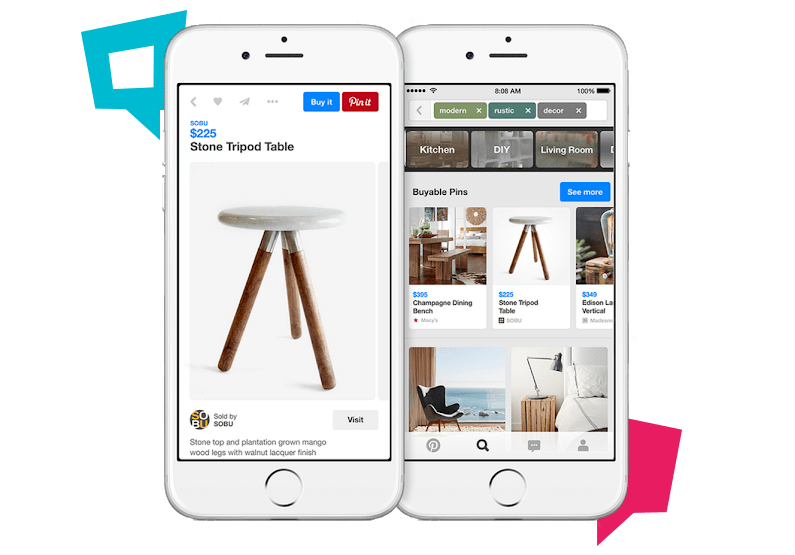Social shopping and social commerce – Help people promote you
Social shopping is not another fancy word or a trend that is just passing by. It became a new way for e-commerce companies to sell more efficiently their products, online. As we already talked about the phenomenon of social shopping in our previous article, we can now certainly say that social shopping uses the best from social media – product sharing and consumer influence and puts it into one shopping experience, created especially for the user.
Around 60% of modern consumers are very open to receiving recommendations from family and friends when shopping – it’s not a shocker that people use social media to search for new products, read reviews and buy products in-app.
But, not only do social media networks like Facebook and Instagram want to make us shop, but retailers are also trying to create their own ways and networks that will influence potential consumers to buy.
That’s why in this chapter we will explore different opportunities that social commerce offers for your business – what apps to use and how to develop a successful social shopping strategy.
How can social shopping grow your sales?
Social shopping is becoming the number one priority for brands that want to get closer to their consumers. Whether you already run a profitable e-commerce business or just starting in the online world, shopping without social media platforms is not an option. 60% of people discover products on Instagram and 78% of Americans use Facebook just to find new products – these statistics alone should convince you that it’s time to invest in social shopping experience.
This all means that your customers are ready to turn to social media to buy in-app and that now is the best time to take your retail business to social media. As the latest report says, people in 2019 spent 1.786 trillion dollars buying consumer goods online which is an increase of 14% compared to 2018.
And with an increasing number of mobile users that spend their time on social media, it’s no wonder that platforms such as Instagram and Pinterest have become destinations for discovering new trends and products.
People no longer have to visit a website or retail store to complete a purchase of your product. Instead, they can scroll through social content while connecting with friends and conveniently buy in just a few clicks. Cutting down the purchasing path, customers can basically buy in three steps and return to their pre-shopping activity easily.
Moreover, social shopping is easy to track – product tags can tell you how many people clicked, saved and purchased an item from a specific post.
It’s also good for content marketing – you can inspire users with great quality photos and copy, leaving product tags to do the dirty work of selling.
Of course, to do all that you need a social media marketing strategy that will involve building relationships with customers, creating valuable and top-quality content, engaging users and many more.
What Social Commerce Plugins and Apps to use?
In times of social shopping buzz, besides social networks that are still figuring the best way to implement social commerce for brands, third parties launched their own plug-ins and apps to promote social shopping. Some brands even took things in their own hands (or apps).
One great example of an app you can use for social shopping on your website is Soldsie, which works with the most popular social media networks – Facebook and Instagram. This third-party app allows your followers to make a purchase just by commenting on a post with the word “Sold.” After customers post the comment, the app takes care of the rest, emailing them an invoice to complete payment and confirm the order.
There are even more examples of social shopping sites that combine the best of social commerce – community and shopping. We will single out the London start-up Shopa that is successfully turning shopping into a regular social media activity. How? Well, Shopa works pretty similarly as other social networks – you have a profile, tools to select favorite items and collections, but with Shopa users get rewarded for their recommendations.
It seems crazy, right? Well, not so much, because we know already that recommendations are the thing people are looking for on social media. And on Shopa users are rewarded with discounts if one of their connections/friends purchases something they’ve recommended.
And this is where the future of social media leads, which means companies need to try out these features. But you are probably thinking, where to start if you want to succeed in social commerce. Luckily, we have the list of best apps and tools to use for selling through social media:
- Pinterest Buyable Pins
93% of active Pinterest users said they use Pinterest to plan for purchases, and 87% said they’ve purchased something because of Pinterest. Pinterest serves as a platform for inspiration for various industries like fashion, home décor or beauty, so it’s not strange that it is also a good start platform for social commerce.
Pinterest’s Shop the Look Pins allows users to click on small white dots on various products within a post, and either purchase that product within the app or browse similar products. They can make purchases on both desktop and mobile.

Image 1: Preview of Pinterest’s shoppable pin
Instagram is without a doubt one of the most popular platforms for social shopping already. It has checkout capabilities and a shoppable post tool. Many Instagrammers are already using the app for discovering and purchasing new products – 80% of users use Instagram to decide whether to buy a product or service.

Image 2: Preview of Instagram product tags
This one was obvious. Facebook is a great place to start with your social commerce journey. With Facebook Business Page you can easily set up a Facebook shop to sell your products and services directly on the platform. Also, you can use a third-party e-commerce platform like BigCommerce to upload all of your inventory or you can manage all by yourself.
For further inspiration, try searching for major retailers and checking out how they’ve set up their Facebook shop. For instance, take a look at New Balance’s Facebook shop

Image 3: Preview of Facebook shop
Besides social media networks, there are apps and platforms that you can use for social shopping, besides the ones mentioned above:
- StoreYa
With StoreYa you can import your existing web store on Facebook. It doesn’t matter what type of site you’re currently running, because StoreYa imports all of your products on Facebook. Moreover, campaigns and promotions are provided, and you can see various reports to view trends and predict what you can expect for the future.
StorYa offers different account types ranging from 9 to 69 $ per month.
- Shop Social
Shop Social is a tool to make your Instagram photos shoppable on your e-commerce site. Instead of giving a single link from a photo, tag multiple products to your posts. The price of Shop Social is $49 per month.
These are just some apps and platforms that we mentioned, there are many more social shopping specialized companies, apps, and platforms. What you need to keep in mind is that all of them demand time and money but will surely bring a good ROI. Learn from big companies like Nike that are already taking advantage of in-app purchases. For example, Nike has optimized their Facebook pages for in-app purchases – they have a Facebook shop and always tag products in their photos.
When followers click on the tag icon, they get the name of the product, description, and price. And just like that their followers can discover products and buy them without leaving the social network.
Social Commerce through built-in tools
Before you jump to your new social media project and start buying monthly subscriptions for social shopping apps, you can look deeper into your e-commerce platform. The platform you’re currently using may already have some tools for you to connect your shop with your social network. This solution would cut out the work and money you would have to invest in the tools we mentioned above.
For instance, BigCommerce has built-in tools for selling on Facebook, Instagram and Twitter and Shopify has several apps that you can choose from for posting your products on all platforms. If you are using WooCommerce and WordPress you can go to the WordPress plugin library.
Whatever you decide, it’s a wise decision to make your decision about an e-commerce platform based on which social sites you can post your products on.
Final Thoughts on Social Commerce
The social media networks are slowly turning into a playground for e-commerce websites, as these are the sites where consumers spend most of their time online.
With new platforms and new updates on the way, we can expect that social commerce will become a common thing for both brands. As they do, consumers will also become more comfortable with in-app shopping.
There is no reason why brands and companies shouldn’t take advantage of social media networks like Pinterest, Facebook, and Instagram to push their products.
If you have an e-commerce site and a provider that has easy integration with social media, it’s a no brainer that you need to do. These platforms will do most of the work for you. And if you don’t you have some work to do. Facebook and Instagram allow creating manual catalogs within the platform, and you can get creative and use all the features as some brands did.
Either way, the bottom line is – you need to invest in your social media strategy. Invest time to create a good marketing strategy where social commerce is in the first plan but also the money to get this kind of project started.
If you have any questions and want to get your social shopping project and strategies started, feel free to contact us.



